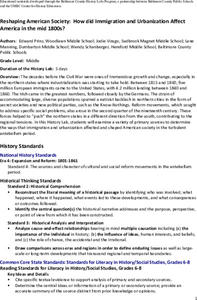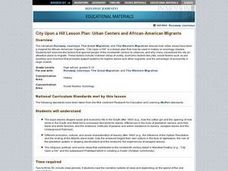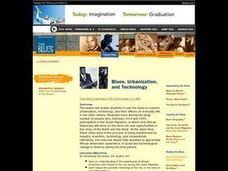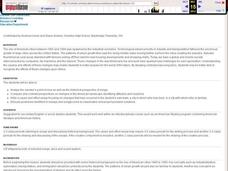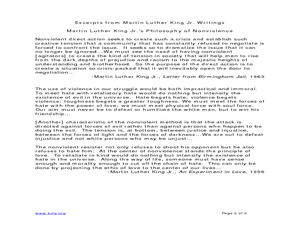Smithsonian Institution
Art to Zoo: Life in the Promised Land: African-American Migrants in Northern Cities, 1916-1940
This is a fantastic resource designed for learners to envision what it was like for the three million African-Americans who migrated to urban industrial centers of the northern United States between 1910 and 1940. After reading a...
Curated OER
The Art and Culture of the Afro-American
Your high schoolers will examine the community in which they live and discuss with the class. Using the Internet, they identify the importance of African-American art and how it relates to the African-American culture. Individually, they...
Center for History Education
Reshaping American Society: How did Immigration and Urbanization Affect America in the mid 1800s?
From the Know-Nothings to the Bible Riots, immigration and urbanization changed the face of America in the middle of the 1800s. Using documents that range from immigrant experiences to renderings of violent conflict between immigrants...
Curated OER
Urbanization As Seen Through Late 19c - Early 20c Architecture
Incorporating the cultures, architecture, and ethnic populations of several American cities (namely Chicago and New York), this presentation displays vivid photographs of buildings and people in 19th - 20th century urban America. The...
Core Knowledge Foundation
Isn’t It Exciting? (The American Industrial Revolution and Urbanization)
America was built on the ingenuity, work ethic, and foresight of our ancestors. Sixth graders learn about the complex Gilded Age in American history, including the prominent inventors and captains of industry, and how they all connect...
Smithsonian Institution
A Ticket to Philly—In 1769: Thinking about Cities, Then and Now
While cities had only a small fraction of the population in colonial America, they played a significant role in pre-revolutionary years, and this was certainly true for the largest city in the North American colonies: Philadelphia. Your...
Curated OER
Big Business & Industrial Cities
This is a true gem. This PowerPoint is well-organized, has bullet points you control (which gives you time for discussion), has sound effects, and covers several aspects of American industrialization after 1900. The presentation begins...
Curated OER
Urban Centers and African-American Migrants
Students read narratives about the experiences of 19th century fugitive slaves that fled to urban centers. They conduct further research on the African-American urban migration movement and present their findings to the class.
Curated OER
Social Studies, Music, The Blues, Urbanization, and Technology
Enable students to use the blues to explore urbanization, technology, and their effects on everyday life in the 20th century. Musicians were among the large number of people who, between 1914 and 1945, participated in the Great Migration...
Curated OER
A Changing Society: Industrialization and Urbanization
Students participate in activities that teach them about the Gilded Age of industrialization and urbanization. In this social changing lesson plan, students answer questions, watch videos, have discussions, read texts, and more to teach...
Smithsonian Institution
Borders and Community: Early 20th Century Chicago Neighborhoods and Ethnic Enclaves
Chicago is one city, four neighborhoods, and countless nationalities. The lesson explores the ethnic division of Chicago in the early twentieth century. Academics read primary sources, analyze maps, and tour an online exhibit to...
Annenberg Foundation
Social Realism
Many American writers in the late nineteenth century wanted their writing to reflect real life. Individuals watch and discuss a video, read and explore author biographies, write a journal entry and a poem, and complete a multimedia...
Curated OER
How Do Artists Effectively Relate Historic Events?
Students explore African American migration. In this black culture and history lesson, students use a map to identify northern and southern states in which African Americans lived in the 1900s. Students observe and describe objects and...
Polk Bros Foundation
American Presidents
Emanuel Leutze's painting Washington Crossing the Delaware. Alexander Gardner's photograph of Abraham Lincoln. What do these works of art tell us about the character of these American Presidents? After examining the techniques the...
Curated OER
American Literature - The American Dream: Past, Present, and Future
Students are introduced to the ideas of the American Dream at the turn of the century. They present their ideas on the American Dream at the turn of the century through a person characterized in Edgar Lee Masters' Spoon River Anthology.
DocsTeach
How Have Americans Responded to Immigration?
While America says it welcomes from other countries the tired and poor yearning to be free, the record is mixed on whether there has been a warm reception for immigrants. Class members use an interactive graphic scale and primary source...
Curated OER
You Don’t Know What You’ve Got Until It’s Gone: The Changing American Landscape
Students examine the changing American landscape. In this cause and effect lesson, students listen to rock music that exemplifies urban growth in America and the interconnectedness of America today. Students write cause and effect essays...
Curated OER
Urban Growth in Industrial America
Students examine the correlation between urbanization and industrialization. In this 19th century American history lesson plan, students investigate census data from the late 1800's to find out how urbanization and industrialization in...
Curated OER
Exploring Native Americans
Students, as a group, read "Sees Behind Trees" about a Native American boy. They discuss how the Native American culture is different from theirs. They also draw Native American scenes and read poetry.
Curated OER
Coming to America: U.S. Immigration
Analyze primary source documents relating the conditions under with prompted American immigration. Learners will analyze information in order to create a six-panel pamphlet. Much of the lesson is not available but the key objectives are....
City University of New York
Urban Politics: Machines and Reformers
What were political machines and whom did they serve? As part of a study of US immigration patterns and how these patterns influenced politics, groups investigate how Tammany Hall and other political machines gained support from voters.
City University of New York
Urban Politics: Machines and Reformers
Take a trip to the turn of the twentieth century with a resource about industrialism in America. With primary source documents and focus questions, learners think about the ways that government groups and organizations paved the way for...
Curated OER
African Americans in California’s Heartland – The Civil Rights Era
Events related to the Civil Rights Movement in Sacramento, California during the 1960s offer class members an opportunity to compare the nonviolent resistance approach favored by Dr. Martin Luther King and the NAACP with those of the...
Curated OER
The Harlem Renaissance: Black American Traditions
Students examine the time period of the Harlem Renaissance. As a class, they are introduced to five artists and discuss their art and techniques. Using the internet, they also research the philosophers of the time period and how...




